HIRADO

Hirado:a travel destination touching peoples'hearts through its history and beauty
| Christianity was first brought to Hirado in 1550. From then until 1873 when anti-Christian edicts were abolished and people were granted freedom of religion, a history of oppression against Christians remained, and many Hirado believers kept their faith hidden. Several churches which survived this era of long historical fear remain in Hirado. They are all attractive and splendid examples of Christian architectural heritage. Viewing them, you are sure to make new discoveries and have a fresh experience when contemplating their rich yet challenging past. In 1549 (Tenmon 18), Francis Xavier, a Jesuit missionary, arrived at Kagoshima. He gave up his missionary work there and visited Hirado the following year where he started new missionary work. Matsuura Takanobu, the feudal lord of Hirado province, supported this missionary work, with the idea that more trade could then be expected with Portugal. Gaining a sudden and large number of Christian followers caused Xavier to believe strongly that there would be more room for missionary expansion in Japan. Many churches were constructed, Latin carols were sung and western medicine was introduced and practiced. However, due to a variety of reasons, a strong anti-Christian sentiment grew and another feudal lord, Matsunaga, led a strong and brutal anti-Christian policy, martyring hundreds of people. But the Faith could not be completely wiped out: Some people, at the mercy of the times, took their faith underground, transforming into “Hidden Christians” which added to Hirado’s own unique history. |
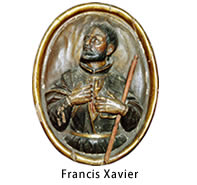 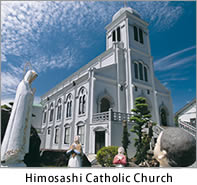 |
In 2007, a group of Nagasaki churches and associated Christian sites were added to the list of domestic candidates for registration as United Nations World Heritage Sites. Approximately 50 Catholic churches built between Meiji and the early part of Showa remain in Hirado as well as in Nagasaki Prefecture.
In recent years, a civic movement was created for the active preservation of these cultural properties. “The Society to Promote Nagasaki Group Churches as World Cultural Heritage Sites” was inaugurated by a group of local scholars and architects. They claim that this group of churches offer universally valuable examples of a unique fusion between Western and Japanese architectural styles. Also, more detailed study would allow us to trace a special aspect in the historical development of architecture.
World Heritage Site candidate lists with Hirado group churches include Tabira Catholic Church (already designated as an important cultural asset by the Japanese Government) and Hoki Catholic Church (designated as a tangible cultural asset by the Nagasaki prefectural government).
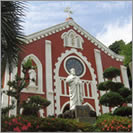 |
Built in 1898. This cathedral has so many interesting architectural features, such as an exterior constructed of bricks laid in an “English Style,” a pointed-arch design, circular windows, and a dome-shaped ceiling. |
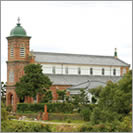 |
Building begins in 1915 by the Catholic Faithful. It took three years to compete. It’s a solemn church built in the Romanesque style of red brick. It’s a representative work of the expert carpenter, Yosuke Tetsukawa. |
The American international school travel program known as “People to People Student Ambassador Programs” founded by former US President Eisenhower aims at contributing to world peace through international exchange tours.
At present, Ms. Mary Eisenhower, the granddaughter of the former President, serves as the representative leader of this organization. It has such a rich history that successive American presidents have become honorary chairmen.
Under the Student Ambassador Programs sponsored by the non-profit corporation known as “People to People” (PTP), over 20,000 American student ambassadors are yearly sent to various parts of the world. In 2008, about 21,000 people were sent on 48 tours throughout the world. In that same year, eight separate “People to People” groups, consisting of a total of 308 people, visited Hirado between June 9th and July 11th. Every student ambassador was welcomed by the Hirado International Institute and stayed for four days (staying at various host families for three nights) and experienced a variety of historical, natural, and cultural experiences at schools and with families.
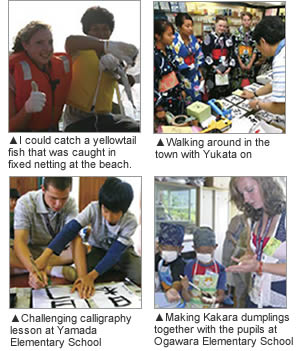 |
That year’s home stay program in Hirado, Ojika, and Nagasaki was rated “No.1 in the World” among 48 tours of school programs which travelled all over the world. According to those who took part, the reason why this program was rated highly was that it was not a just sightseeing exchange program. The sincerity of the local residents who received the students as true family members was deeply conveyed through their experiences in the city and in the homes. The students were highly satisfied with their exchanges with the local people. Examples of feedback include the following: “It is appreciated that we were welcomed by the schools and the participating families. They treated us as if we were their family members.” “Arriving in Hirado, I was able to have a real exchange with Japanese people. ” |